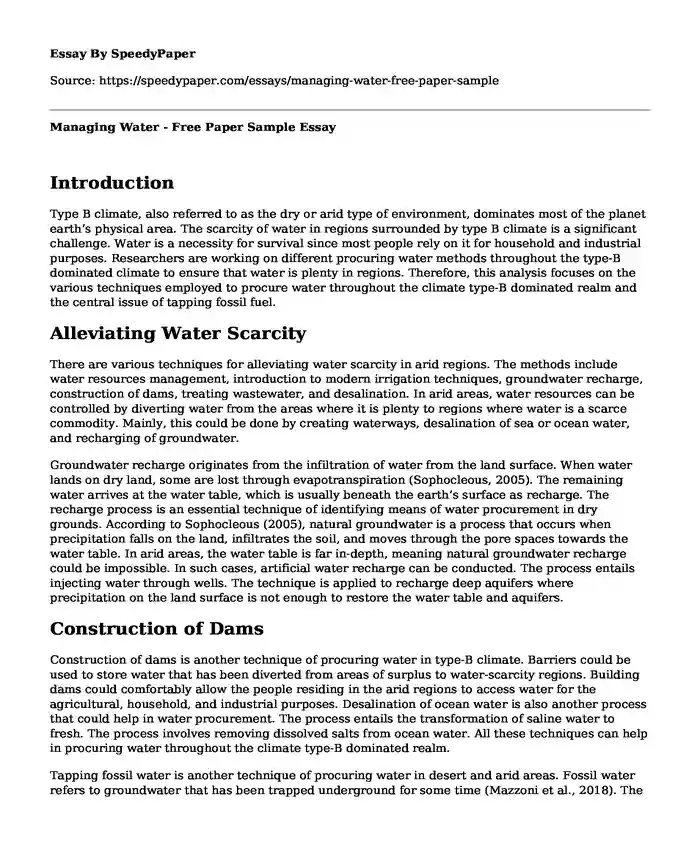Introduction
Type B climate, also referred to as the dry or arid type of environment, dominates most of the planet earth’s physical area. The scarcity of water in regions surrounded by type B climate is a significant challenge. Water is a necessity for survival since most people rely on it for household and industrial purposes. Researchers are working on different procuring water methods throughout the type-B dominated climate to ensure that water is plenty in regions. Therefore, this analysis focuses on the various techniques employed to procure water throughout the climate type-B dominated realm and the central issue of tapping fossil fuel.
Alleviating Water Scarcity
There are various techniques for alleviating water scarcity in arid regions. The methods include water resources management, introduction to modern irrigation techniques, groundwater recharge, construction of dams, treating wastewater, and desalination. In arid areas, water resources can be controlled by diverting water from the areas where it is plenty to regions where water is a scarce commodity. Mainly, this could be done by creating waterways, desalination of sea or ocean water, and recharging of groundwater.
Groundwater recharge originates from the infiltration of water from the land surface. When water lands on dry land, some are lost through evapotranspiration (Sophocleous, 2005). The remaining water arrives at the water table, which is usually beneath the earth’s surface as recharge. The recharge process is an essential technique of identifying means of water procurement in dry grounds. According to Sophocleous (2005), natural groundwater is a process that occurs when precipitation falls on the land, infiltrates the soil, and moves through the pore spaces towards the water table. In arid areas, the water table is far in-depth, meaning natural groundwater recharge could be impossible. In such cases, artificial water recharge can be conducted. The process entails injecting water through wells. The technique is applied to recharge deep aquifers where precipitation on the land surface is not enough to restore the water table and aquifers.
Construction of Dams
Construction of dams is another technique of procuring water in type-B climate. Barriers could be used to store water that has been diverted from areas of surplus to water-scarcity regions. Building dams could comfortably allow the people residing in the arid regions to access water for the agricultural, household, and industrial purposes. Desalination of ocean water is also another process that could help in water procurement. The process entails the transformation of saline water to fresh. The process involves removing dissolved salts from ocean water. All these techniques can help in procuring water throughout the climate type-B dominated realm.
Tapping fossil water is another technique of procuring water in desert and arid areas. Fossil water refers to groundwater that has been trapped underground for some time (Mazzoni et al., 2018). The waters are deep in aquifers and are the primary source of groundwater in type-B climates. Harnessing such water could be detrimental to the future of groundwater sourcing in regions. By bringing fossil water to the surface, water quality issues are likely to result. Fossil water depletes aquifers, resulting in an influx of contaminants of the water (Mazzoni et al., 2018). The depletion of fossil water aquifers can reduce pressure emanating from underground and make large quantities of water hard to retrieve. Saudi Arabians attempted to tap fossil water, and the process ended up sucking up rare water, which is detrimental to those residing in the type-B climate. Therefore, fossil water could deplete aquifers is the main issue hindering the tapping of fossil water in desert and arid areas.
Conclusion
In conclusion, the type-B climate is also referred to as dry and arid environments. In such regions, water scarcity is a significant problem, considering that water is vital for survival. The proposed techniques of procuring water in such areas include water resource management, dams construction, groundwater recharge, and desalination. All these methods can solve the issue of water scarcity in arid regions. Tapping fossil water is also a solution with detrimental consequences. The process lowers underground pressure hence making it challenging to access water from aquifers in the future.
References
Mazzoni, A., Heggy, E., & Scabbia, G. (2018). Forecasting water budget deficits and groundwater depletion in the main fossil aquifer systems in North Africa and the Arabian Peninsula. Global Environmental Change, 53, 157–173. https://doi.org/10.1016/j.gloenvcha.2018.09.009
Sophocleous, M. (2005). Groundwater recharge and sustainability in the High Plains aquifer in Kansas, USA. Hydrogeology Journal, 13(2), 351–365.
https://doi.org/10.1007/s10040-004-0385-6.
Cite this page
Managing Water - Free Paper Sample. (2023, Nov 24). Retrieved from https://speedypaper.com/essays/managing-water-free-paper-sample
Request Removal
If you are the original author of this essay and no longer wish to have it published on the SpeedyPaper website, please click below to request its removal:
- Free Essay Sample on Whether Animals Have Rights
- Free Essay Sample on the Innovations of Electricity
- Shale Oil Production in the USA, Free Essay for Your Inspiration
- Free Essay: Environmental Problems in the African Continent and Ways to Address the Problems
- Is Hunting Necessary? Get the Answer in the Essay Sample
- Essay Example: Wilderness, Climate Change, and Traditional Knowledge
- Free Essay Example - Malthusianism
Popular categories





